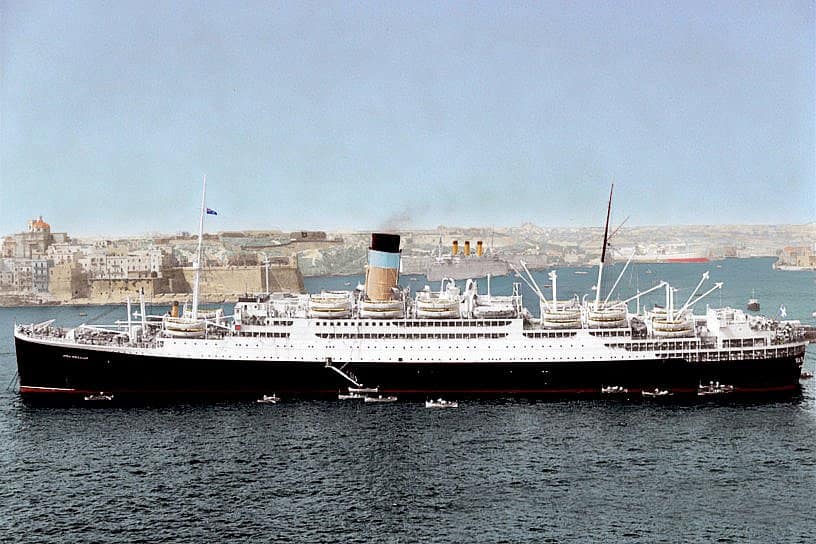She was born in Glasgow, Scotland, carried allied troops across the Atlantic and around the world, carried immigrants from the Old World to the New World, and after four decades of service, met an uneventful end halfway across the globe. But to the thousands of individuals that sailed this graceful lady of the sea, she will always be remembered as the Nea Hellas.
She was built in 1921 in Glasgow by Fairfield Co, LTD, for the Anchor Line, which was founded in 1856. She was originally named Tuscania and weighed 16,991 gross tons, and could hold 267-1st class, 377-2nd class, and 1,818-3rd class passengers and 200-crew. The ship was a state of the art engineering, and the 578.4 foot long and 70.3-foot wide ship, with one funnel and two masts, and the six steam turbines and twin screws enabled her to reach sixteen knots.
On April 19, 1939, she was sold to the Greek Line, formerly known as General Steam Navigation Company of Greece, owned by the Goulandris Brothers, renamed T.S.S. (Turbine Steam Ship) Nea Hellas (New Greece), and refitted to carry 200-cabin, 400-tourists, and 500-3rd class passengers. As the first ship to sail for Greek Line, she departed Piraeus on her maiden voyage on May 19, 1939. The New York Herald Tribune reported on her arrival and the many parties held for New York’s social elites, diplomats, and businessmen. However, after about fourteen Atlantic crossings, war broke out in Europe, and she was placed under the allied command and put into service as a troop transport. For seven years, the ship sailed the world carrying troops and other passengers who needed to get back home and was dubbed the “Nelly Wallace,” by the men she carried into war.
After the war, in 1947, she was returned to her Greek owner and served as Greece’s flagship. Her original route was Piraeus to New York, with stops in Genoa and Lisbon, and eventually adding, Naples, Malta, and Halifax, and other cities. The Greek journal “Naftika Chronika” (Nautical Chronicles) wrote that the ship had restaurants and halls, good furnishings, and it was “nicely decorated.” During her life, she carried over 800,000 Greek and other European immigrants to Canada and the United States, some fleeing the Nazis, others leaving behind post-war poverty in Europe, but most to be with families that had previously traveled to the New World, or simply to start a new life.
She continued her transatlantic route until 1955 when she was replaced by the Olympia. Eventually, the Nea Hellas was renamed New York. On October 13, 1959, she started on her last voyage on the route, Piraeus – Palermo – Naples – Genoa – Quebec – Genoa – Naples – Messina and finally returning to Piraeus on November 14, 1959. On August 19, 1961, at age thirty-seven, and twenty years serving Greece, she left Piraeus and sailed for Onomichi, Japan, where she was reduced to scrap iron.
The grand old lady was gone, but the memory of the Nea Hellas sailed on in the minds of those that were fortunate to roam her decks, eat in her restaurants, and enjoy life on the seas, albeit for a few weeks. Although she never had the status of other more prominent ships that sailed the Atlantic, she was the workhorse that allowed thousands and thousands of individuals and families to travel to the New World and a new life.



